Levers to Lumbar Perfection: How Many Ways Does That Seat Go?

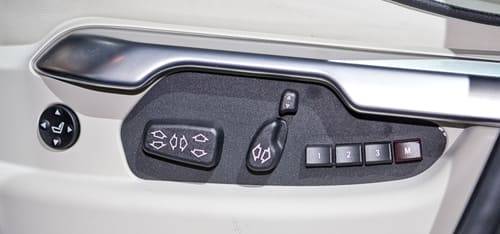
CARS.COM — When it comes to car seats, one size fits few. To ensure the family vehicle accommodates both mom and pop, cars have offered adjustable front seats since the early days. These days, even the cheapest economy vehicles have seats that employ cranks and levers to allow a surprising number of movements, while luxury cars have veritable command centers that ensure total support for your every muscle.
Related: How to Properly Adjust Your Head Restraint
Now there are more controls than ever. Case in point: A $24,000 Volkswagen Passat comes standard with a 12-way power seat, which begs the question: How the heck can a seat move 12 different ways? Armed with a camera and the sort of posture only a 13-hour work day can produce, we set out at the Chicago Auto Show to find out.
We checked dozens of vehicles, with prices ranging from $13,000 to more than $100,000. Our goal: Document all the ways a seat can be adjusted and see if there’s a point at which it does too many things.
Here’s what we found.
One-Star Seating: Two- and Four-Way Manual Adjustments
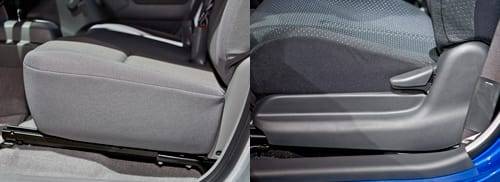
In the ballgame of car seats, these are the 400-level bleachers. The Toyota Tacoma pickup truck takes bottom “honors,” as Toyota saw fit to leave a basic — really basic — single-cab model among its spiffier TRD siblings at Chicago’s McCormick Place. Crank windows and plastic bumpers weren’t the only order of the day: The Tacoma’s bench seat adjusts exactly two ways — forward and backward. The backrest, here and in some other bench-seat pickups, is fixed.
Just about every other car adds a reclining backrest, which bumps the adjustment count up to four. You’ll find four-way seats in only the most basic vehicles — examples include the Honda Fit’s sculpted buckets and the Toyota Yaris’ not-so-sculpted seats. One bonus for the Fit: Its front seats have additional levers mounted near the head restraints that move the chair along its track, so backseat passengers can annex new legroom by giving their cohorts a friendly shove.
Coach Class: Six-, Eight- and 10-Way Manual Adjustments
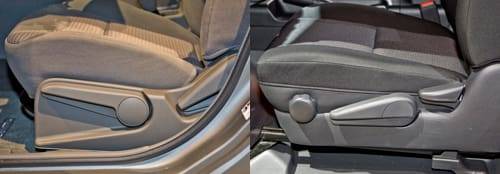
Most manual seats also have a height adjuster, which allows drivers to position themselves at a height that optimizes headroom and driving position. Some cars, like the Chevrolet Aveo, use a knob to achieve this. We’re bigger fans of pump-jack-style adjustments, like the one in the Nissan Sentra. It’s easier to yank a lever a few times than it is to crank a knob again and again. Not that every jack strikes our fancy: The Nissan Versa puts its flimsy adjuster to the right of the driver’s seat, which is, to put it charitably, an awkward spot.
Higher up the chain are cars like the Toyota FJ Cruiser, whose manual seat packs a height adjuster and a seat angle adjuster to change the tilt of the cushion. Others, like the newly introduced Hyundai Elantra Touring, forego the angle adjustment but have a lever to adjust lumbar support. The Volvo C30 takes the cake for manual adjustments, with both lumbar support and an angle adjuster in its base trim. We should mention the angle adjuster here is an easier-to-use lever rather than the FJ’s knob. That offers 10 ways to adjust — not too shabby.
Button Beginnings: Basic Power Adjustments

Once the levers and knobs reach critical mass — but before you get a fully powered seat — some cars will throw in a limited number of power adjustments, like the power backrest tilt in certain trims of the Volkswagen Jetta. We’re especially intrigued by the Volkswagen R32’s four-way power lumbar support: It inflates the support but also moves it up or down your back. That sort of functionality has typically been confined to pricier luxury cars — yet every other adjustment in the R32’s seat is manual. It’s sort of like having Pecorino Toscano grated over your Easy Mac.
More typical are six-way power adjusters that move the cushion height and angle, as well as sending the seat forward and backward along its tracks. In these cases, the backrests recline manually. Examples include the Ford Escape’s optional power seat; the Ford Fusion, meanwhile, adds a manual knob for lumbar support alongside those power adjusters.
Moving On Up: Eight- and 10-Way Power

Most garden-variety power seats are adjustable eight ways, allowing six adjustments for the seat (forward or backward, height up or down, and angle pitching forward or back) and powering the backrest recline. Examples include the Mazda CX-7, which throws a manual lumbar adjustment in the seatback. We snubbed the knob adjuster earlier on, but we actually prefer them for lumbar support, as they allow near-infinite adjustment. A simple lever, in contrast, can stop in just a few positions.
The 10-way power seat puts you squarely in business class. Most examples are basically an eight-way seat with power lumbar, and you usually don’t find them until you move up to a premium nameplate or a full-size car — like the Hyundai Azera’s leather-trimmed seat.
Lap of Luxury: 12-, 14- and 16-Way Power
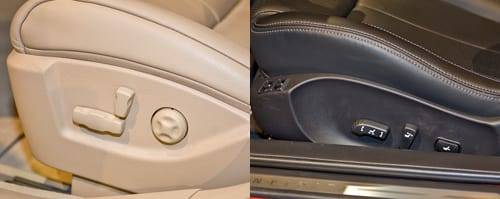
Beyond 10-way seats, carmakers have to get a bit creative, so it’s hard to group the controls together. The Cadillac STS offers as conventional a 12-way adjustment as you’re likely to find, with four-way lumbar and eight-way cushion/seatback movements. Its larger sibling, the Cadillac DTS, adds a back massager.
The Infiniti G37 upgrades to adjustable cushion and seatback bolsters, a real bonus for sporty drivers. There’s also a seat cushion extender that adds thigh support in front of the seat, for a total adjustment count of 16.
The Jaguar XK, meanwhile, goes without any seat-cushion bolster adjustments (the seatback bolsters are still adjustable) but adds four-way power lumbar and a power cushion extender. That gives its 16-way seats a leg up (excuse the pun) on Infiniti, whose cushion extender is manual. We should also note that the XK’s controls are on the door, a much more accessible location than alongside the seats. More cars ought to do this.
If a dozen-plus ways to pamper yourself isn’t enough, well, you obviously have deep pockets (and if you ever throw a party, you ought to invite us), because you’re clearly into …
Total, Wanton Excess: 18-Way and Up
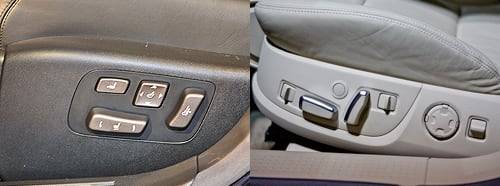
Sybaritic seatwork knows no limits. We’re not sure whether a seat actually needs a power cushion extender and power-elevating head restraints, but the Lexus LS 600h offers both — and it also powers the position of your seat belt in the B-pillar, up and down. If you count the seat belt, that’s 18 awe-inspiring ways to settle into your car.
Not enough? The Audi A8 L has all that plus a backrest that can adjust for lower and upper angles, basically adjusting its concavity against your spine. The head restraints have their own bolsters, too, which can be extended to provide lateral cushioning for your noggin. Total adjustment count? 22. Think about it: That’s more adjustments than your neighbor’s Toyota Camry has for its driver’s seat, passenger seat and steering wheel — combined. Be sure to tell him that at the next block party.
And we could go on. By the time we shot the luxury cars, Mercedes and BMW officials had packed up for the day, and most of their cars were locked up. The same was true of exotic brands like Maybach and Rolls-Royce. It’s entirely possible one of them has more controls lurking, though we’re not entirely sure what those controls would do. (Behold, power shoulder-pad extensions! Comfort for all body parts!)
Back to the original question: Is there a point at which you have too many buttons? When we started out, we thought so. But umpteen cars later, those cushion extenders and headrest retractors don’t seem so bad. We may need more time in that Audi to investigate.
Cars.com’s Editorial department is your source for automotive news and reviews. In line with Cars.com’s long-standing ethics policy, editors and reviewers don’t accept gifts or free trips from automakers. The Editorial department is independent of Cars.com’s advertising, sales and sponsored content departments.

Former Assistant Managing Editor-News Kelsey Mays likes quality, reliability, safety and practicality. But he also likes a fair price.
Featured stories



